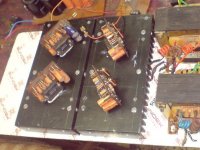I'm building this multi-amp to drive my DIY speakers. They are 4-way active dipole prototypes with MiniDSP crossovers.

Currently they are powered by 8-channel ClassD amps. They're great except not liking the 2 ohms nominal tweeter impedance (paralleled, the back tweeters are not visible). I did a study on the distortion between gainclone and ClassD before at the acoustic output here.
The 8-channels gainclone amps are based on AudioSector 4780 kit:
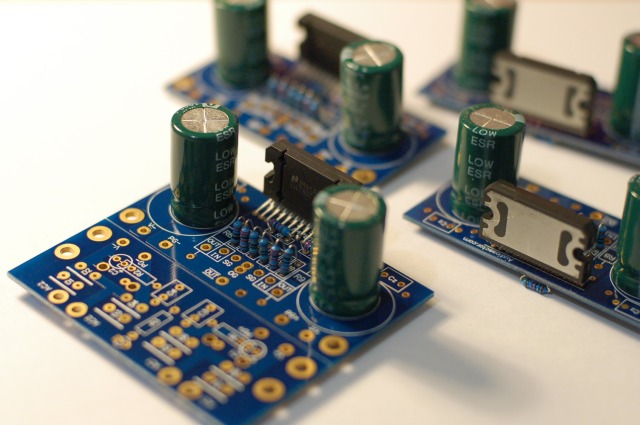
As seen above, I'm using no-fuss components sourced from local provider here (Jaycar). I did the effort, however, to painstakingly measure the resistors individually before using it.

Currently they are powered by 8-channel ClassD amps. They're great except not liking the 2 ohms nominal tweeter impedance (paralleled, the back tweeters are not visible). I did a study on the distortion between gainclone and ClassD before at the acoustic output here.
The 8-channels gainclone amps are based on AudioSector 4780 kit:

As seen above, I'm using no-fuss components sourced from local provider here (Jaycar). I did the effort, however, to painstakingly measure the resistors individually before using it.
Member
Joined 2009
Why not save yourself the extra work and just add 2 Chipamp channels to your existing Class D amp? You can match channel levels in the miniDSP.
Do you expect them to sound very different?
Do you expect them to sound very different?
An amp for each driver. I like your thinking 😎
I have spare place for 4 more channels. A future 12-channels amp!
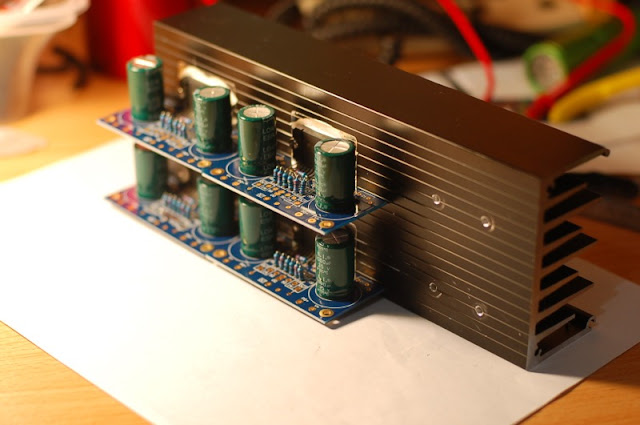
re: why not just use the GC for tweeter and the rest class D? Well I don't want complexity. Multi-PSU and all. But it would have been workable and no difference in the sound 😉
I have spare place for 4 more channels. A future 12-channels amp!

re: why not just use the GC for tweeter and the rest class D? Well I don't want complexity. Multi-PSU and all. But it would have been workable and no difference in the sound 😉
Currently they are powered by 8-channel ClassD amps. They're great except not liking the 2 ohms nominal tweeter impedance (paralleled, the back tweeters are not visible). I did a study on the distortion between gainclone and ClassD before at the acoustic output here.
Class D amps are especially happy with low impedances. The trouble at the top end lies in the passive low pass they need to convert the PWM output back to a sine wave. The filter will only work perfectly at one specific impedance. The solutions are either to adapt the filter to the load the actual speakers pose or to linearise the speaker load to the impedance the filter was designed for.
Often the amp designers assume that the load is resistive for the filter design. The actual frequency-dependant impedance of a real loudspeaker will then warp the frequency response in an undesired manner. That is why many people report that class D amps sound harsh, edgy or even piercing. An impedance linearisation for the tweeter solves that issue.
The amps are easy enough to wire, although not as easy as ClassD 😉
What is critical is the star grounding. If done incorrectly the output will hummmmmmmm...
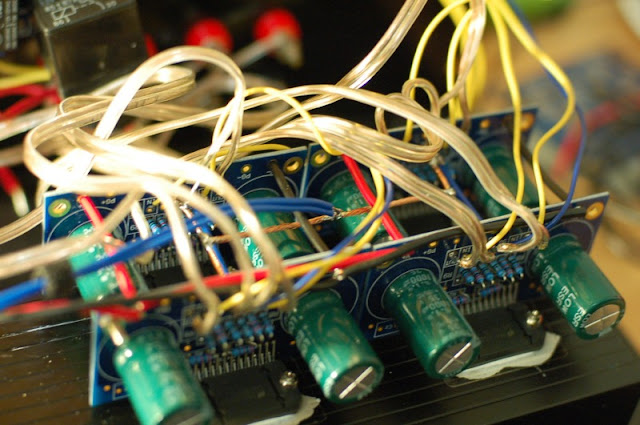
You are correct, but I don't think Sure TA2050 which are harsh. In fact my study above proved the distortion is the same as gainclone. Yes the frequency droop can be fixed by changing the output filter. But in my case it's much simpler to correct it at the DSP.
What is critical is the star grounding. If done incorrectly the output will hummmmmmmm...

Class D amps are especially happy with low impedances. The trouble at the top end lies in the passive low pass they need to convert the PWM output back to a sine wave. The filter will only work perfectly at one specific impedance. The solutions are either to adapt the filter to the load the actual speakers pose or to linearise the speaker load to the impedance the filter was designed for.
Often the amp designers assume that the load is resistive for the filter design. The actual frequency-dependant impedance of a real loudspeaker will then warp the frequency response in an undesired manner. That is why many people report that class D amps sound harsh, edgy or even piercing. An impedance linearisation for the tweeter solves that issue.
You are correct, but I don't think Sure TA2050 which are harsh. In fact my study above proved the distortion is the same as gainclone. Yes the frequency droop can be fixed by changing the output filter. But in my case it's much simpler to correct it at the DSP.
Last edited:
Member
Joined 2009
It looks like a great project! I would love to build a multichannel amp one day for my active 3-way speaker. My skills are not up to point where I'm comfortable to tinker around with things that run on mains voltage. For the moment I decided to buy a used multichannel receiver and work with that. I must say though the sound quality on the lower and mid-end receivers is unacceptable.
I hope you do a thorough write up on this one, I enjoy reading about your projects.
How many toroids are you planning to use, they can get pretty big and heavy as power requirements grow.
Would you please go over correct grounding practices in detail (again)?
How do plan to handle volume control? Multichannel volume control in the amp should give the best gain structure.
I hope you do a thorough write up on this one, I enjoy reading about your projects.
How many toroids are you planning to use, they can get pretty big and heavy as power requirements grow.
Would you please go over correct grounding practices in detail (again)?
How do plan to handle volume control? Multichannel volume control in the amp should give the best gain structure.
The star grounding looks something like this.
The choice of conductor between the boards are critical. Use the thickest possible. 4 to 5mm (!) would be great. But here I use 3mm which is fine.

I learnt a lot from this post "Understanding star grounding"
http://www.diyaudio.com/forums/power-supplies/115698-understanding-star-grounding.html#post1403905
The choice of conductor between the boards are critical. Use the thickest possible. 4 to 5mm (!) would be great. But here I use 3mm which is fine.

I learnt a lot from this post "Understanding star grounding"
http://www.diyaudio.com/forums/power-supplies/115698-understanding-star-grounding.html#post1403905
Last edited:
Here you can see 160VA, 25v-0-25v Toroidal transformer that I use.

Initially I was just trying it and planned for a bigger one (300VA). However there is no problems using it driving the speakers to deafening level. It is well known that dipoles are very easy speakers to drive (e.g. the woofers operate at their inherent Fs). Hence I keep it.
The cabling could be much neater, but I prefer keeping them long, in case another swap with ClassD is needed 😎
You can compare the look with ClassD:

Initially I was just trying it and planned for a bigger one (300VA). However there is no problems using it driving the speakers to deafening level. It is well known that dipoles are very easy speakers to drive (e.g. the woofers operate at their inherent Fs). Hence I keep it.
The cabling could be much neater, but I prefer keeping them long, in case another swap with ClassD is needed 😎
You can compare the look with ClassD:
An externally hosted image should be here but it was not working when we last tested it.
This is a very good album to ensure maximum current flowing out of those chipamps 

At neighbour-engaging levels, the gainclones stabilises at "4-second touch" heat. Pretty hot, but does not seem hot enough to trip their thermal protection 😎
The 4x H-frame dipole woofers are equalised to 20hz, Q=0.707.


At neighbour-engaging levels, the gainclones stabilises at "4-second touch" heat. Pretty hot, but does not seem hot enough to trip their thermal protection 😎
The 4x H-frame dipole woofers are equalised to 20hz, Q=0.707.
I noticed the noise / hiss of these amps are higher than my classD, which is surprising. Note that I am using waveguides on the Tweeters which raises the sensitivity to additional +6db to +10db too. The gain might bee to high too on the gainclone.
The hiss can be reduced by applying decoupling caps on the chips (100nF) and the PSU's AC inputs (120nF)
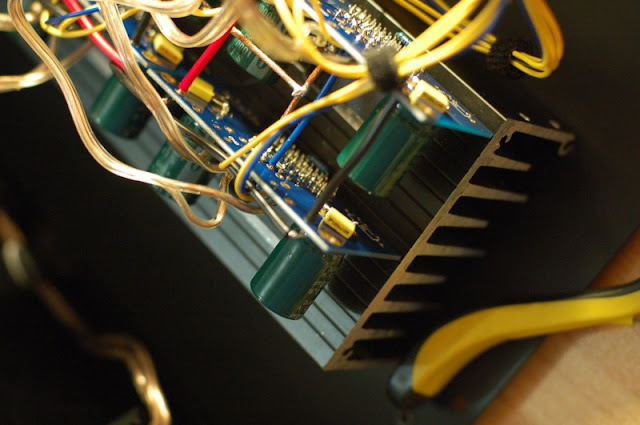

The hiss can be reduced by applying decoupling caps on the chips (100nF) and the PSU's AC inputs (120nF)


Have you measured the noise on the output?
Have you checked to see if the PSU is ringing/oscillating?
Have you checked to see if the amplifier is ringing/oscillating?
Have you checked to see if the PSU is ringing/oscillating?
Have you checked to see if the amplifier is ringing/oscillating?
No, I do not have oscilloscopes.
The behaviour of the amps seems like a stable one. Not hot etc. The hiss is audible from 1m which is too much for my liking.
I could reduce this further by lowering the amp's gain, or implementing LPAD to the tweeters. So not really a drama. The tweeter's sensitivity had been increased due to waveguide.
The behaviour of the amps seems like a stable one. Not hot etc. The hiss is audible from 1m which is too much for my liking.
I could reduce this further by lowering the amp's gain, or implementing LPAD to the tweeters. So not really a drama. The tweeter's sensitivity had been increased due to waveguide.
I noticed the noise / hiss of these amps are higher than my classD,
Have you checked your pre-amp and/or sources for the hiss?, It could be that the low pass filter in the output of the class D amp could help filter out any hiss, where as with the class ab amps the hiss could pass straight though
Hey Andi, nice looking speakers. I came across this thread because I'm having the same problem as you (although with a different cause, I'm sure). My 4 way dipoles also have an audible hiss, which after living with for a number of months, has to go.
For me, the noise is coming from my miniDSP unit (which I think you're also using). My problem is that I need my volume control to be after the miniDSP, not before it. What do you use?
I like your amp setup. I built 8 channels of custom amps, point to point, and it is way too big, way too complicated, expensive, and way more power than I need. I really should have gone with GC amps...
For me, the noise is coming from my miniDSP unit (which I think you're also using). My problem is that I need my volume control to be after the miniDSP, not before it. What do you use?
I like your amp setup. I built 8 channels of custom amps, point to point, and it is way too big, way too complicated, expensive, and way more power than I need. I really should have gone with GC amps...
the temperature of the heatsink looks high '4 sec finger touch' 🙂 . It looks quite small for 8 channel amplifier. I used 2 heatsinks for a similar setup but still they run hot ' say 12 sec finder touch'.
Attachments
Last edited:
- Status
- Not open for further replies.
- Home
- Amplifiers
- Chip Amps
- 8-Channel Gainclone Amplifier
